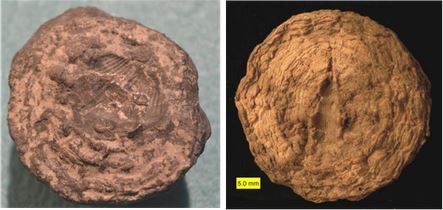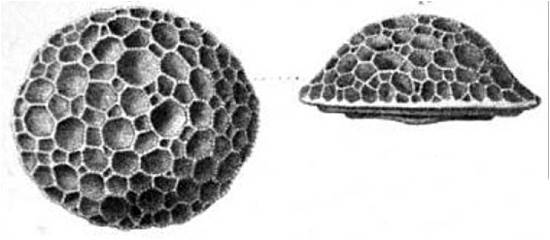I have had an active interest in mineral collecting for several decades (five years in Arizona can do that to anyone), but have developed a growing interest in fossils since moving to western New York two years ago. Having completed my first full season of mucking up creeks and stopping at roadcuts in the Silurian and Devonian strata of western New York I can announce that I now have a favorite fossil.
I realize many are, and for very good reason, enamored with trilobites. Be they DiPleura, Greenops, Dalmanites, or Eldredgeops , those are certainly great finds and I will be more than happy to pick one up when I come upon it. But I took a fancy to a simple tabulate coral species this summer: Pleurodictyum americanum, a species first described by the German paleontologist Carl Ferdinand von Roemer in the late 19th century. Note his original drawings in the featured image for this post (Roemer, 1876).
Perhaps it is the near perfect symmetry of the colonial coral that grabbed my eye. With a rounded top and a fairly flat bottom they certainly look grand once clay and shale is washed from the polygonal corallites covering the surface. Even better presentation results when multiple specimens of variable size are displayed together. My interest was also sparked because “pleuros”, as I have come to affectionately call them, are not as common as horn coral or many of the brachiopods species that are ubiquitous at many sites in the Finger Lakes region, but they are also far from rare and when found they are typically complete and recoverable.
Given they are more resistant than the shale and siltstone within which they resided for the past 380MY, polished specimens of the Middle Devonian coral can be collected along the shorelines of many of the Finger Lakes. Their shape and surface features cause lake visitors to call them “turtle stones” when they encounter them along the lakes. However, my favorite way to find them is in place, with their tops exposed by erosion, and where they can be easily released from their hosts with a little care and some well placed chiseling.

I have found them on the east side of Canandaigua Lake and on both sides of Seneca Lake this summer and can envision developing a location collection of 1-3” spherical “pleuro” coral in coming years. As a member of the coral family Favositidae, they are indeed one of the coral species commonly referred to as “honeycomb coral”.
A most interesting aspect of “pleuros” is their propensity to initiate growth on an existing fossil such that the flat underside contains the mold of that fossil. What’s more, Brett and Cottrell (1982) reported that the preferred fossil for such growth was the elongate spiral-shaped gastropod (snail) known as Palaeozygopleura hamiltoniae. They further concluded that the colonial coral encrusted the shells only after the snail itself was dead and gone. You may recall that we collected a squashed version of this snail genus in the Upper Wanakah section at Deep Run in July (see September WCGMC newsletter).

References:Brett, C.E., and Cottrell, J.F., 1982, Substrate specificity in the Devonian tabulate coral Pleurodictyum, Lethaia, v. 15, p. 247-262.
Roemer, F. von., 1876, Lethaea geognostica: handbuch der erdegeschichte mit Abbildungen der fϋr die formationen bezeichnendsten Versteinerungen, I. theil, Lethaea paleozoica, E. Schweizerbartsche Verlagshandlung (E. Koch), Stuttgart, Germany.
Wooster, 2011, Wooster’s Fossil of the Week: A tabulate coral (Middle Devonian of New York), Wooster Geology Blog Site, Sept 4, 2011.
